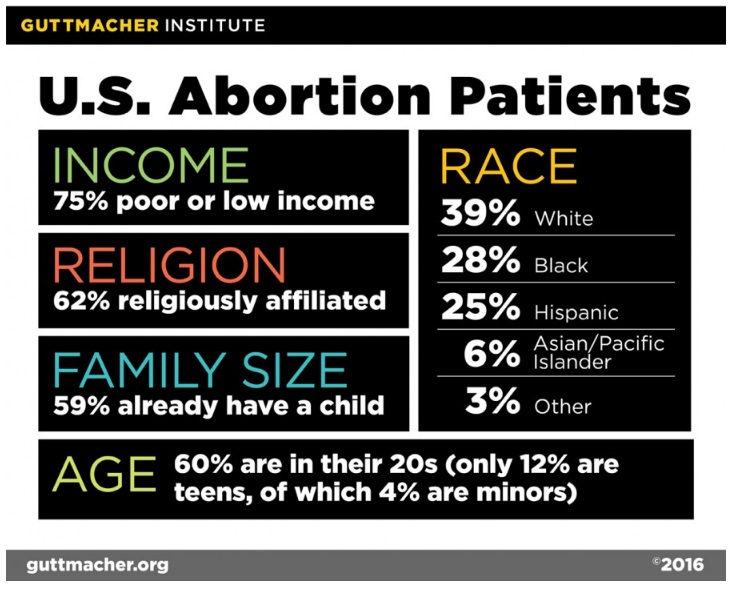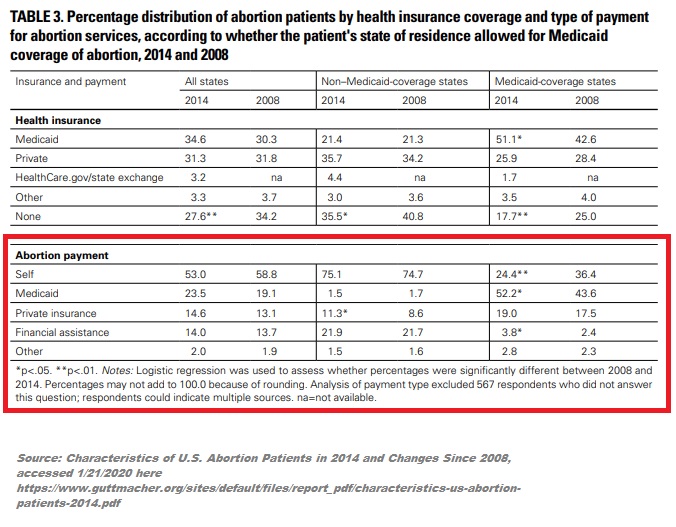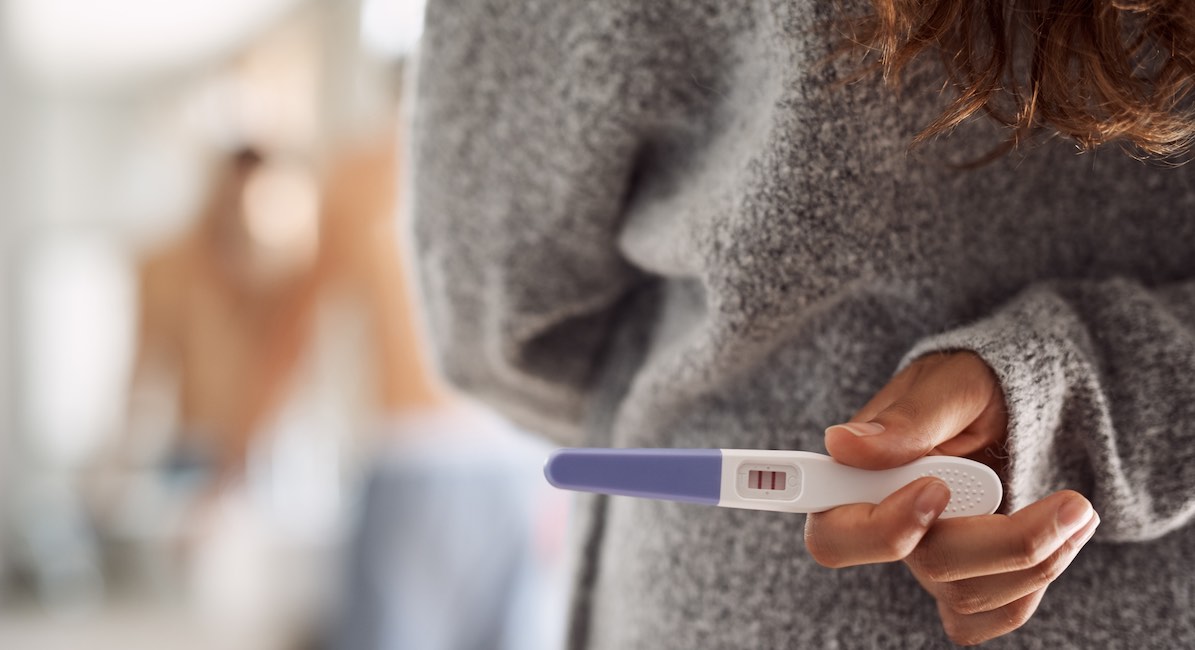Characteristics of women who obtain abortions are regularly detailed by two reporting agencies: the Centers for Disease Control and Planned Parenthood’s former “special affiliate” and research arm, the Guttmacher Institute. There are a number of differences in the two reporting agencies, including numbers of overall abortions reported as well as when the data is released. The most current reports are from the CDC (2018) and Guttmacher (2017). However, as Guttmacher has not yet analyzed patient characteristics for 2017, the group’s data still reflects 2014 numbers. Live Action News has summarized these reports below, and some of the numbers are surprising.
Women in their 20s have the majority of abortions
The CDC (2018) reports that among the 48 areas that reported abortion numbers by women’s age for 2018, just as in 2016, women in their 20s accounted for the majority (57.7%) of abortions and had the highest abortion rates (19.1 and 18.5 abortions per 1,000 women aged 20-24 and 25-29 years, respectively).
In 2018, women in the youngest (<15 years) and oldest (≥40 years) age groups accounted for the smallest percentages of abortions (0.2% and 3.6%, respectively) and had the lowest abortion rates (0.4 and 2.6 abortions per 1,000 women aged <15 and ≥40 years, respectively). Abortion ratios in 2018 were lowest among women aged 25-39 years (126-189 per 1,000 live births).
The Guttmacher Institute (2014) reports:
- Patients aged 20–24 obtained 34% of all abortions.
- Patients aged 25–29 obtained 27% of all abortions.
- In 2014, more than half of all U.S. abortion patients: (60%) were in their 20s while 25% was in their 30s.
Adolescents /Teens
- Adolescents <15 accounted for 0.2% of reported abortions (abortion rate of 0.4%).
- Adolescents 15–19 years accounted for 8.7% of reported abortions (abortion rate of 6%)
- 2009 to 2018: reported abortions decreased among adolescents age 15 or less by 60% and those aged 15-17 by 43.2%.
- 2009 to 2018: abortion rates decreased among adolescents (64% and 55% for adolescents aged <15 and 15–19 years, respectively).
Guttmacher’s 2014 numbers note that 12% of abortion patients were adolescents. Those aged 18–19 are counted among adolescents instead of among adults, and they accounted for 8%, those 15–17: 3%, and those under 15: 0.2%. Adolescent abortion patients declined 32% between 2008 and 2014.
Longer term data (between 1980 and 2017) reviewed by Dr. Michael New, reveals that the abortion rate for females between the ages of 15 and 19 fell by more than 82 percent while the abortion rate for 35-to-39-year-olds fell by only 8.5 percent during the same timespan.
“The large reduction in the teen abortion rate is partly the result of a higher percentage of pregnant teenagers choosing life for their preborn children. According to these new statistics, the percentage of pregnancies carried to term by women ages 15 to 19 between 1980 and 2017 increased by more than 10 percent. An even more important reason for the drop in the teen abortion rate is that teenagers are now much less likely to become pregnant in the first place. According to Guttmacher, the teen pregnancy rate peaked in 1990 at 117.6 pregnancies per thousand teenaged females (girls 15 to 19). Since then, the teen pregnancy rate has declined by a whopping 73 percent.” Dr. New wrote.

Character of abortion patients (Image: Guttmacher/ 2016)
Abortion percentage by race/ethnicity
In 2018, 619,591 abortions were reported to CDC from 49 reporting areas. However, due to limited state requirements, the percentage (below) is based on a total of 350,124 abortions for race/ethnicity reported among31 reporting areas.
- Non-Hispanic white women: (38.7%).
- Non-Hispanic Black women: (33.6%)
- Hispanic women: (20.0%)
- Other: (7.7%)
According to Guttmacher’s 2014 numbers, by race, the numbers were…
- White patients: 39%
- Black patients: 28%
- Hispanic patients: 25%
- Patients of other races and ethnicities: 9%
Read a complete analysis from Live Action News on race/ethnicity abortions here.
Previous Live Births
CDC data reveals women who obtained abortions in 2018,
- Nearly 41% had no previous live births.
- Nearly 25% had one previous live birth.
- Nearly 20% had two previous live births.
- Nearly 15% had three or more previous live births.
Guttmacher’s 2014* numbers show:
- 40.7% had no previous live birth.
- 26.2% had one.
- 33.1% (one-third) had two or greater.
- 59% percent of abortions obtained by patients who had had at least one birth.
- 60% of patients aged 35 and older reported having a prior abortion, compared with 38% of those aged 20–24.
- Patients who had at least one birth were more likely to have already had an abortion than those who had never given birth, even after taking age and other characteristics into consideration.
Previous Induced Abortions
The CDC’s 2018 report showed that nearly 60% of women who obtained an abortion had no previous abortions, nearly 24% had one previous abortion, nearly 10% had two previous abortions, and just over 6% previously had three or more abortions.
Guttmacher (2014)* notes that:
- Almost half (45%) of U.S. abortion patients had at least one previous abortion.
- Patients who had been exposed to two or more disruptive life events (such as losing a job or breaking up with a romantic partner) in the previous year were more likely to have had a prior abortion than those who had not experienced such events.
- Patients who paid for their abortion procedures with their own funds were less likely to have had a prior abortion than those who used health insurance or received financial assistance.
- Likelihood of having had a prior abortion decreased as the patient’s distance from an abortion facility increased.
- Compared with patients who are white and college educated, black patients and those lacking a college degree were more likely to obtain at least a second abortion or more.
- In 2014, more than half (51%) of abortion patients were using a contraceptive method in the month they became pregnant.
Religious affiliation
According to Guttmacher (2014), most (38%) of women getting abortions reported no religious affiliation. 24% were Roman Catholic, 17% were mainline Protestant, 13% were evangelical Protestant, and 8% were another affiliation.
Relationship status
Guttmacher (2014) reported about 14% of abortion patients were married, 31% were cohabiting, and a slight majority were not living with a partner in month they became pregnant (46% had never married and 9% were previously married).
Self-Managed Abortion (outside FDA approved requirements)
Guttmacher’s 2014 survey notes 1.3% of abortion patients reported that they had at some point taken misoprostol to self-induce an abortion, up from 1.2% in 2008. Patients who reported using substances other than misoprostol declined from 1.4% in 2008 to 0.9% in 2014.
Late-Term Abortions
The following were more likely than others to have had an abortion at or beyond 13 weeks’ gestation, according to Guttmacher (2014):
- Women with less education
- Black women
- Women who had experienced multiple disruptive life events in past year.
Live Action News analyzed additional demographics here.
Income, Nativity, Education
From Guttmacher (2014):
- In 2014, three-fourths of abortion patients were low income—49% living at less than the federal poverty level, 26% living at 100–199% of the poverty level.
- 16% were born outside U.S. — about half were Hispanic, 20% Asian, 16% black and 12% white.
- 84% were born in the U.S.
- 9% of abortion patients aged 20 or older had less than a high school degree, 91%—had graduated from high school; more than one in five had a college degree.
- The proportion of patients aged 20 or older who had not graduated from high school declined significantly over the six-year period (from 12% to 9%).
- 24% of all abortion patients were currently attending school, including 72% of minors and 53% of 18–19-year-olds.
- Only 14% of those currently in school had not graduated from high school
- 66% of abortion patients had some college or a college degree.
Payments/Medicaid patients

Abortion by payment and Medicaid national 2014 (Graph: Guttmacher)
From Guttmacher (2014):
- Average cost paid of an abortion with local anesthesia in a nonhospital setting at 10 weeks’ gestation was $508.
- Average paid for early medication abortion (up to nine weeks’ gestation) was $535.
- Abortion patients were less likely to have no health insurance coverage in 2014 than 2008 (28% vs. 34%).
- 35% percent had Medicaid coverage, however, despite the Hyde Amendment barring federal dollars from paying for abortions, in 2014, Guttmacher reported, “Medicaid was the second-most-common method of payment and was reported by 24% of abortion patients.“
- 31% had private insurance, but some policies did not cover abortion.
- 15% paid for abortion using private insurance.
- 14% paid for abortion using financial assistance.
- 24% paid for abortion using taxpayer dollars such as Medicaid.
- 53% paid out of pocket.
Editor’s Note 12/7/20: This article was updated with more recent data.
Editor’s Note, 3/30/20: This article was updated with additional, more recent data.
*Additional sources may also be linked.
“Like” Live Action News on Facebook for more pro-life news and commentary!







